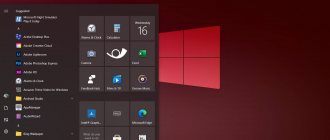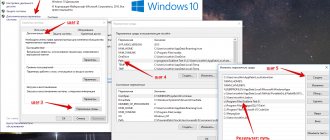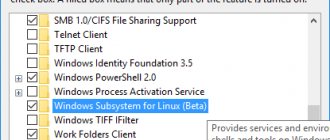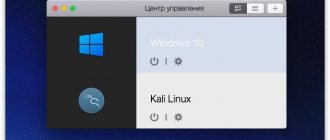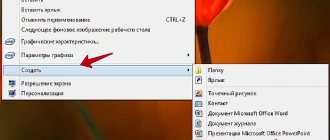Convenient implementation of updates
We are probably all familiar with this situation. You turn on your computer in the morning to do important and urgent work, and Windows 10 suddenly pleases you with a bluish screen and the message “Working with updates.” Apparently, Microsoft is hinting that your business can wait. And if you don't have the most powerful configuration, the update can take an indecently long time.
Yes, the forced reboot has been removed from the operating system, and now you can set an interval during which the computer should refrain from doing it. But still, in the Home version of Windows 10 you will not be allowed to delay updates for longer than 12 hours. Some users are so annoyed by this need that they resort to all sorts of tricks to disable the function.
Linux doesn't have the problem of a long update during which you can't do anything. All patches are installed in the background while you work, surf the Internet or listen to music, and do not interfere with the use of your computer. And rebooting after an update in Linux occurs as usual - no “28% left” signs hanging for an hour. And finally, you can simply ignore operating system updates and not install them - it will not try to object to you.
Characteristic distinctive nuances
Many potential users are unlikely to appreciate the quality of Linux or Windows until they encounter the technical side of the operating “stuffing” installed on the device.
Both systems, both Linux and Windows, are also as different as heads and tails in comparison. At first glance, the differences seem unnoticeable, but if you look deeper, the difference between them is colossal. Each has its own set of advantages and disadvantages, let's start with the most important thing, with the developers:
- Windows is a ready-made OS with great working functionality, officially registered by Microsoft Corporation. A serious technical drawback of Microsoft's brainchild is the constantly running updates. It's difficult to disable them. If a problem, bugs or malfunction of your computer arises after the next automatic update, then the only option to solve it is to contact technical support. Some consumers simply put up with this, others are looking for an equivalent replacement.
- Linux is a design platform from the Unix family. The platform is based on a monolithic “core” around which all sorts of distributions are built. The system is a flexible, dynamic frame for various modifications. All the application programs surrounding it provide exceptional cost-effectiveness, creating a complete multi-functional operating environment.
In order to get a comprehensive answer to the question of which software shell is better, it is necessary to review all the parameters.
Easy application installation
Have you ever felt that the Windows Store is, to put it mildly, a little useless? No, of course, and you can find worthwhile applications in it if you wish.
But for the most part, when we need to install a program, we open a browser and go to the software developer's website to download the installation file from there. And then open it, allow execution, press the “Next” button several times... A bunch of unnecessary actions.
All popular Linux distributions have convenient application stores that download and install programs from repositories (online sources). And it's very convenient.
Do you need to install Firefox, Skype or Telegram? No need to search for them on Google. Check them out in the store or package manager, click one “Install” button, and after a few seconds they will appear on your computer.
Another advantage of Linux repositories is that updates for all programs come from one source and are installed simultaneously. Along with the system patches, the browser, video player, and everything else will be updated.
There is no situation in Linux where you launch a program, it prompts you to update, and you have to wait for the new version to download and install.
For those who like to play
For all fans of virtual games who mostly use hardware to run all kinds of games, installing Windows OS would be an excellent choice. This does not mean that you cannot download games on Linux instead of Windows, you can.
Popular virtual games run without any problems on both platforms, but if you compare Windows and Linux, the first one wins. Linux, even with its multi-faceted functionality, can hardly be called a prepared “playable” platform.
The prospects for gaming on Linux can be found in this article.
The best option for installing games is Windows! The platform is fully prepared and compatible in terms of parameters with almost all existing games developed for PC. The weak side of this coin is that access to the virtual world of computer entertainment is provided for a fee.
No intrusive programs
Windows 10 comes with a huge number of so-called universal apps built into it. Some of them, like Mail and Calendar, can be useful.
But why do you need a Mixed Reality Portal if you don't have a VR headset, a 3D Viewer if you're not a modeler, and an Xbox if you don't play on a Microsoft console? Moreover, in the Home edition of Windows, new applications that you did not ask for may well install themselves if Microsoft decides that you need them.
The presence of such programs in the Start menu is only annoying, and they also take up extra disk space. Of course, they can be disabled or deleted, but this will require time and unnecessary gestures.
There is no such problem in Linux. The system will never force you to use certain applications, persuade you to use a specific default browser, or install anything without asking. If you need a ready-made system with built-in offices, calculators and players, download the distribution kit where all this is enabled by default and use it.
Do you want to control what and how will be installed on your computer? Start installing the system using Net Installer and check the boxes of which programs you need and which you don’t. Nothing extra.
Variability
The most striking advantages of Linux have been collected over many years from thousands of projects. This is a rich built-in set of configurations, in which you will not find anything. The design system is very flexible, allowing you to do literally everything the client wishes.
There is an opinion that the software shell was created for IT specialists, but in recent years it has become much more accessible and simpler than it was before. For beginners, naturally, initialization will be a little difficult at first; you will need to spend a lot of time and conduct an introductory course, but it’s worth it!
But an average familiarity with the settings will already allow users to create miracles in the “constructor”! Having free access to the entire multifaceted potential of the designer, which has about 300 supported distributions, you can create a variety of software tools and change working environments every day.
It's great! Tailor the operating shell to suit your needs, tastes, and needs, independently eliminating what you consider unnecessary. This is simply a colossal contrast in comparison with Microsoft products, in which the developer decides everything!
Light system weight
Windows 10 is a rather heavy option that takes up a lot of disk space. On average, after installing and downloading all updates, 25–35 GB of the system partition will be filled. But you still have to install a browser, an office suite, a media player and everything like that.
This will especially please owners of budget laptops with a small amount of built-in memory. The Windows 10 ISO installation file alone weighs more than 4 GB - I wonder what they crammed in there?
The Linux Mint distribution, for example, weighs 1.8 GB, and it already contains an office suite, media players, a tool for creating backups, and a lot more. After installation it will take up about 4.8 GB. Moreover, this is a rather heavy distribution. And there are also very tiny ones that will eat up no more than 700 MB.
How to Prepare to Switch to Linux
1. Create a bootable USB flash drive with your favorite operating system assembly according to the instructions above.
2. Look in the list of Linux applications for analogues of the programs you need. One of the best video players for the platform is VLC, the most omnivorous audio player is Audacious, and the graphics editor is GIMP. The office suite can replace LibreOffice, and the role of the main browser will be taken by Chromium or Firefox.
Make sure replacements for all important applications are found.
3. Be prepared for the fact that some of the computer components will not be recognized by the operating system. Everything can be solved by searching and installing the necessary drivers. It’s easy to “Google” a way to solve the problem if you have the Internet.
Sometimes after installing Linux, Wi-Fi refuses to work, which makes it difficult to find a solution. Here, for example, are instructions for installing drivers for Broadcom network cards.
You will have to use a second computer or connect your laptop to the router via a patch cord unless you download the necessary packages in advance.
4. Decide on the partitioning of the drive. It is better to leave a physical or logical disk with the Windows operating system. You may want to allocate space for storing files and data, or you may want to carve out the space as you see fit.
You can partition the drive both from Windows and during the installation of Linux.
5. Use an existing flash drive to install a full-fledged operating system.
High level of performance
Owners of not the fastest and newest computers and laptops on which Windows 7 was installed have probably noticed how slow the system becomes after updating to “Ten”. This is especially noticeable on devices without SSD. When Windows 10 tries to install updates in the background or downloads programs from the Microsoft Store, the computer literally starts howling with all the fans.
Linux has much lower hardware requirements and can run even on very modest configurations, which makes this operating system an ideal candidate for installation on low-power or old computers. Some distributions can exist quite well on devices with 128 MB of RAM!
Customizable interface
There is little that can be changed in the Windows 10 interface. You can experiment with window color or theme, or add or remove tiles to the Start menu. But that's basically all. You will not be able to change the shape of windows and the taskbar, move the notification panel from the right edge, or change anything else. You'll have to use what Microsoft designers came up with.
Linux gives users almost complete freedom of customization. It has a lot of desktop skins that you can change as you wish. Do you want a super-modern interface with lots of transparency, pop-ups and other goodies? Or maybe you need large icons and menu items for a touch screen? Or do you prefer a conservative and minimalist option for a low-power computer? The choice is great.
Design customization
Windows allows standard means to change only the color of windows. Large-scale changes to the design of the panel and applications are prohibited.
In GNU/Linux there are no restrictions on changing the appearance: from fonts to window title design. There are many standard themes, and it is also possible to install additional ones from the Internet.
Flexible control
Microsoft thinks it knows better how you should use your computer. The window control buttons are located on the right, and you can’t argue with that. The selected window cannot be docked on top of others (without using third-party tools) - which means you don't need to. Put the shutdown and reboot buttons from Start on the taskbar - what are you talking about? But there is only one active corner - the bottom right one, and it minimizes all windows. He doesn't have to do anything else.
In contrast, Linux allows you to customize the behavior of the interface as you wish. If you prefer to use hot corners to launch programs, you just need to enable them in the settings. Need a global menu bar like macOS? You can add it to almost any shell by simply installing the desired extension. Why, even the order and location of the window control buttons can be changed.
High level of security
Although Microsoft has done a lot of work to improve security in the Ten and even built in its own good antivirus, Windows still remains a vulnerable system. It is for this purpose that most viruses and malware are created.
Another problem with Windows is adware. You download some useful thing, launch the installer, recklessly without looking at the checkboxes, and in addition you get someone else’s home page in your browser, a bunch of toolbars and extensions, some kind of “Yandex.Browser” and all sorts of similar stuff. Even very high-quality and popular programs are guilty of such dirty tricks. The same AIMP player, for example.
Linux is almost completely virus-free. There is no adware in it either. And you don’t have to worry about doing something wrong and installing something nasty.
Software
When you purchase Windows, you find that the only useful applications are the proprietary browser, image viewer, and multimedia player. The rest of the software is purchased separately, most of which are paid.
The main advantage of a Microsoft product is the availability of any software. Any program that runs on macOS or GNU/Linux is available for Windows (albeit in an alternative version). Modern games, devices, and software for working with multimedia are developed for Windows.
For GNU/Linux, the number of applications has increased significantly over the past 5 years. New programs, equipment, games - everything is being ported at a high pace to run on Linux.
Software that was originally supported on Linux continues to evolve. Enthusiastic developers from all over the world write useful utilities and programs to diversify the choice of Linux users.
Almost any distribution, upon detecting the connection of a new device, will immediately install the necessary driver for it. The exception is non-free drivers for Nvidia video cards, Wi-Fi modules, and some processor models for laptops, which are easily installed through the hardware configurator.
For any field of activity (biology, chemistry, programming), GNU / Linux is the ideal environment, since it provides unambiguous and useful tools that are missing in Windows or that try to provide similar functionality.
Free distributions
Gone are the days when you could upgrade to Windows 10 for free. Now for the licensed home version of “Ten” you will have to pay $199, and even more for the Pro edition. If you are not ready to take this money out of your pocket, and your conscience does not allow you to become a pirate, try Linux.
This system is completely free. You can download any distribution from the official website, install it, and it will never ask you for money or make you doubt its “authenticity.”
There are, of course, several Linux distributions with paid commercial support, such as Red Hat Enterprise Linux. But they are aimed at corporate use and are not needed at home.
Free programs
Even after purchasing Windows 10, your spending isn't over yet. Next in line is the purchase of a Microsoft Office package or some kind of graphic editor such as Adobe Photoshop. Another blow to the pocket.
The Linux app stores are just full of free programs that can be installed with one click. Graphic and office editors, options for video processing, archivers and other stuff. Of course, the free analogues are somewhat inferior to the commercial ones, but they are enough for home use.
Complete confidentiality and privacy
There are many problems with telemetry in Windows 10. The system diligently sends information to Microsoft about what applications you install, what sites you visit, and where you are. Of course, this data is anonymized, and in general everything is for your own good.
True, by delving into the settings, this feature of the system can be disabled, but there is no guarantee that with the next update it will not be activated again.
Linux has no telemetry. As a last resort, on some distributions you can manually submit a bug report to the developers, and the system will ask your permission before doing so. However, this is optional and can be easily disabled.
Wide variety of distributions
Windows 10, by and large, exists only in two guises - Home and Pro (there are also all sorts of Enterprise and Enterprise LTSB, but they are not for mere mortals). The difference between them is small: the Pro version has a little more functions and capabilities, but they are all securely hidden in the depths of the operating system and are not particularly interesting to the average user.
Linux is very diverse. There are a large number of distributions that can satisfy a variety of needs. For comfortable homework there are Linux Mint and Ubuntu, for lovers of beauty - Kubuntu and Neon, for fans of everything new and experimental - Arch and Manjaro.
There are also distributions for programmers, for paranoids, for owners of old hardware, for creating media centers and home servers... There are plenty to choose from. Take a look at the DistroWatch website, for example, and see what's popular there.
Why switch to Linux
◆ Linux and most software are free. Of course, you can buy Windows 10 for 300 rubles and not worry, but the majority of modern users still pirate the OS and most of the software.
If you want to stop digital piracy, start by installing Linux. This will also be a significant advantage if you come to work with your laptop.
◆ Linux has an application store. When users, after reinstalling Windows, begin setting up third-party software, they either go to torrents or begin an entertaining journey through file-sharing trash heaps and advertising sites in search of the installer of the desired program.
Just don’t say that Windows has its own application store, I already tried how it works and almost went crazy.
Linux users can easily install all the necessary software in a couple of mouse clicks and not worry that after installation they will have to clean the system of all kinds of mail.ru agents or Amigo browsers.
◆ Linux architecture is less susceptible to viruses. Most malware is now developed specifically for Windows. Difficulties in finding applications and the desire of users to download something for free literally open the door to Trojans and viruses.
Linux has a more complex system of access rights, the modularity of components and a monolithic kernel provide much greater security than the “leaky” system registry in Windows.
◆ Linux consumes less computer resources. For modern PCs with multi-core processors and a double-digit amount of RAM, this will not be an advantage, but an old system unit or laptop with two cores and a couple of 2 GB RAM sticks on Linux will simply come to life.
This is a great advantage if you want to give your outdated PC to your parents or grandparents, decide to set up a dusty laptop for distance learning for a child, or want to set up an idle system unit as a media server.
◆ Linux is open source. This allows enthusiasts to find vulnerabilities faster and developers to fix them. This approach also allows you to instantly identify spyware or malicious parts of the code, warn the public about it and abandon the problematic distribution.
How much do users know about surveillance mechanisms and spyware scripts in Windows? Some of them are known to the enthusiast community, but they will have to be disabled manually after installing the system.
◆ Linux has many distributions. If dividing Windows into versions is aimed only at disabling features for the user that he does not want to pay for, then in the Linux world there are truly different builds from each other.
There are distributions that are well optimized for certain hardware, for example, Clear Linux OS from Intel. There are versions with an emphasis on protecting user data, anonymity and privacy, like Kodachi. There are assemblies that literally revive old hardware and are undemanding to resources, for example, antiX or SliTaz (the image of the latter takes up less than 100 MB and can be completely stored in RAM).
The Ubuntu Ultimate Edition build boasts a full set of pre-installed software and drivers. Some of the most popular and stable distributions are Debian and Ubuntu, and one of the simplest and friendliest is Linux Mint.
◆ Linux has a large number of graphical interfaces and controls. These are not just changeable wallpapers, decorations or RAM-eating additions. These are specially designed modules that can be added or removed as needed, making the system the way the user wants it to be.
The most experienced ones can even get by with the command line without a graphical interface, and the most meticulous ones can turn Linux into almost a complete resemblance of Windows or macOS.
◆ Almost any version of Linux can be run from a flash drive. The so-called Live mode is available in most common builds and distributions. You can try any version of Linux, look at the graphical interface, built-in software and drivers without completely reinstalling the system.
Similar versions are also convenient to use for system recovery or even on computers without a drive. This version of the OS starts from a flash drive in a couple of minutes and everything is ready to go.
All this makes Linux a more attractive operating system for many Windows users.
